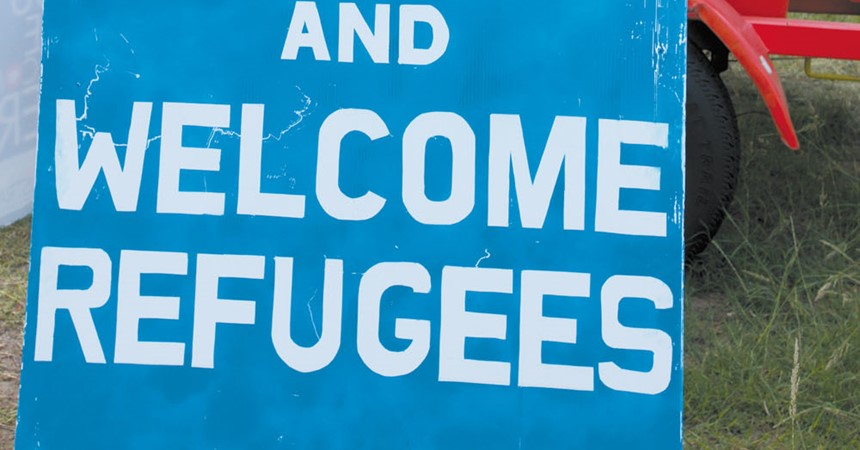These are the lucky ones, the refugees fortunate enough to cross international borders into neighbouring countries in search of safety and protection.
The majority of these people now live in Syria’s four neighbouring countries: Turkey is host to nearly three million Syrians; one million are residing in Lebanon; a further 657,000 are exiled in Jordan and 250,000 are stranded in Iraq. A fraction of those displaced – just over 10 percent – has sought safety in Europe.
Though none of these four countries of refuge is a signatory to the Refugee Convention, they have, for the most part, honoured its most fundamental principles. They have respected a person’s right to seek asylum by keeping their borders open. They have not penalised people for not having the correct documentation for legal entry into their countries. They have allowed access to the United Nations refugee agency (UNHCR) and other UN agencies, and they are co-operating in the provision of humanitarian support. Most importantly, they have upheld the international legal principle of non-refoulement (the right not to be returned to persecution).
This is not to say that the countries of refuge neighbouring Syria have not experienced enormous political, social and economic problems as a result of the influx of such unprecedented numbers of refugees. Nevertheless, their refusal to shut their borders as the crisis unfolded provides a stark (and challenging) example of what the structure of protection for refugees should look like.
These key tenets of the global protection regime are often referred to as the ‘architecture of protection’. While far from perfect, this system was designed in the aftermath of the Second World War to provide a basic framework that would provide protection to people fleeing wars and persecution. For the framework to stand strong, each pillar must be upheld by all countries – regardless of whether they have signed the convention relating to the status of refugees. If one or more states decide to close their borders, or to return people to danger, the whole structure begins to crumble.
Australia’s Operation Sovereign Borders policy has helped to undermine and destabilise this system of protection. The Australian Navy currently intercepts any boat containing people seeking asylum and prevents them from entering the country. People are denied access to a proper refugee status determination and are subjected to ‘enhanced screening’ or an attenuated assessment process. Without a proper assessment the government cannot genuinely determine whether it is safe to return asylum seekers to their country of origin and risks breaching the international principle of non-refoulement, the cornerstone of refugee protection.
Australia’s ‘enhanced screening’ process brazenly flouts the convention: hundreds of Sri Lankan and Vietnamese asylum seekers have been denied access to a fair and comprehensive hearing of their claims, and over a thousand have been forcibly returned to their countries of origin. Here, some have been arrested, detained, interrogated and tortured.
Countries have a right to secure borders and to regulate movement across those borders. That right, however, cannot be allowed to render void the right of people to cross borders to seek asylum under the conventions of international law. Signatories to the convention – such as the Australian government – should not countenance a system in which people do not receive a fair and timely hearing of their asylum claims, nor should they repatriate people to countries where they may face persecution, harm and violations of their human rights.
By stopping the boats, the Australian government is effectively cherry-picking whom they consider to be worthy of consideration as people seeking protection. Former Prime Minister John Howard was one of the first to articulate this policy when he infamously said “We will decide who comes to this country and the circumstances in which they come.” The government has extended this line of reasoning by arguing that by stopping the boats Australia is able to offer more places to UN-recognised refugees waiting in camps.
Yet in so doing the government has conflated resettlement with asylum. While the refugee convention obliges signatories to provide protection and rights to those who arrive in their territory or enter an area under their jurisdiction, it doesn’t stipulate that signatories must resettle refugees currently living in other countries.
There is also a risk that Australia’s hostile policies will further weaken the international architecture of protection through contagion: countries observing Australia’s approach may decide to adopt similar policies of deterrence such as the closing of borders, refusal to conduct proper assessments of protection claims and the return of asylum seekers to their countries of origin.
When studied with a broad lens, it becomes apparent that Australia’s narrow focus on its domestic political challenges is placing the entire global protection regime in jeopardy. If Syria’s neighbours – Turkey, Lebanon, Jordan and Iraq – had adopted the policies of the Australian government, untold numbers of Syrians now living in relative safety would have died.
Increasingly, Australians are questioning whether it is time to bring an end to offshore processing. It is essential during such a process of reflection that we do not accept boat turn-backs as an inevitable response to displacement in our region. When understood from a global perspective, it is clear that the policy of turning back boats fatally undermines the architecture of protection and the inalienable right of people to seek refuge from harm.
Oliver White is Assistant Director, Jesuit Refugee Service.
This is the second article in a five-part series exploring the impact of Australia’s ‘stop the boats’ policy. The following articles will examine the effectiveness of the global resettlement program as a solution for the worlds displaced; the ethics and morality of stopping the boats; and finally, what an effective regional plan for refugee protection would look like.
Read Stopping the Boats Part I – Why stopping the boats does not solve the problem




























































































